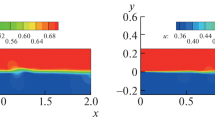Abstract
A physical model has been constructed to represent turbulent recirculating flows that occur in argon-stirred ladles. By using a mechanically driven circulating system including a moving tube it was possible to generate flow fields such that all the boundary conditions could be defined unambiguously. The velocity fields developed in the system and the spatial distribution of the turbulent kinetic energy were measured experimentally using a laserdoppler anemometer. The experimental measurements were found to be in good agreement with predictions based on theK-W model for turbulent recirculating flows, provided appropriate wall functions were used. A simplified model was also described in the paper, for representing the transient decay of turbulence in teemed systems or in bubble stirred vessels after the agitation had been terminated. This model, which in essence involved the use of a simple algebraic relationship, gave semiquantitative agreement with measurements.
Similar content being viewed by others
Abbreviations
- C d :
-
sipation rate constant,
- C i ,C 2 ,C 3 :
-
constants of theK- W model,
- C 1′,C 2′,C 3′:
-
functions of the Reynolds number of turbulence,
- D :
-
rate of dissipation of turbulence energy per unit volume,
- E :
-
constant in the law of the wall,
- f :
-
Kolmogorov’s mean frequency of turbulence,
- F :
-
frequency function,
- F o :
-
frequency function at zero decay time,
- G :
-
rate of generation of turbulence energy per unit volume,
- H t :
-
height of the tank (liquid level),
- K :
-
kinetic energy of turbulent motion-per unit mass of fluid,
- l :
-
length scale of turbulent motion,
- l 0 :
-
length scale of turbulence at zero decay time,
- n :
-
normal distance from the wall,
- r :
-
radial distance or coordinate,
- R b :
-
radius of the belt,
- R t :
-
radius of the tank,
- S W :
-
source rate ofW per unit volume,
- V¯,V¯ r, V¯z :
-
time-averaged velocity vector and its components inr andz direction,
- V¯ o :
-
velocity of the moving solid surface,
- V¯ p :
-
velocity parallel to the wall boundary,
- V′ r,V′z V′θ :
-
fluctuating velocity components in ther, z and θ direction,
- W :
-
characteristic property of turbulent motion,
- X iX J.oi :
-
values of the variable at thei- th node atn-th and (n— 1) iterations, andz axial coordinate.
- ξ :
-
θ-component of the vorticity vector,
- ψ :
-
stream function defined in Eqs. [3] to [4],
- μ,μ t,μe :
-
molecular, turbulent and effective viscosity of the fluid,
- ρ :
-
density of the fluid,
- v :
-
kinematic viscosity of the fluid,
- σK,σW :
-
Prandtl-Schmidt number forK andW,
- t s :
-
shear stress at the wall,
- δi (i= 1,2, 3 or 4):
-
thickness of the chosen wall layer,
- k :
-
constant in Eq. [8],
- Σ:
-
turbulence energy dissipation rate,
- θ :
-
angular coordinate.
References
A. D. Gosman, W. M. Pun, A. K. Runchal, D. B. Spalding, and M. Wolfshtein:Heat and Mass Transfer in Recirculating Flow, Academic Press, London and New York, 1969.
D. B. Spalding:VDI-Forschung., 1972, vol. 38, no. 549, p. 5.
J. Szekely, H. J. Wang, and K. M. Kiser:Met. Trans. B, 1976, vol. 7B, p. 287.
J. Szekely and S. Asai:Trans. ISIJ, 1975, vol. 15, p. 276.
J. Szekely and K. Nakanishi:Met. Trans. B, 1975, vol. 6B, p. 245.
R. J. Adrian:A Versatile Two-Dimensional Laser Doppler System, Dept. of Theoretical and Applied Mechanics, University of Illinois, Urbana, Illinois, 1968.
N. W. Berman: Final Report, Contract NAS8-21397,1969.
W. K. George and J. L. Lumley:J. Fluid Mech., 1973, vol. 60, Part II, p. 321.
H. Wang: MS Thesis, State University of New York at Buffalo, 1975.
S. V. Patankar and D. B. Spalding:Heat and Mass Transfer in Boundary Layers, 2nd Ed., Int. Textbook Co., London, 1970.
K. H. Ng and D. B. Spalding: Imperial College Mech. Eng. Dept. Report BL/TN/A/14, 1969.
A. H. Dilawari: Ph.D. Thesis, University of London, 1972.
R. Metz: MS Thesis, State University of New York at Buffalo, 1977.
B. E. Launder and D. B. Spalding:Comp. Methods Appl. Mech. Eng., 1974, vol. 3, p. 269.
K. Nakanishi, J. Szekely, T. Fujii, Y. Mihara, and S. Iwaoka:Met. Trans. B, 1975, vol. 6B, p. 111.
E. D. Tarapore and J. W. Evans:Met. Trans. B, 1976, vol. 7B, p. 343.
A. H. Dilawari and J. Szekely:Met. Trans. B, 1977, vol. 8B, p. 227.
J. Szekely and C. W. Chang:Ironmaking Steelmaking, 1977, no. 3, (Part I), p. 190.
J. Szekely and C. W. Chang:Ironmaking Steelmaking, 1977, no. 3, (Part II), p. 196.
Author information
Authors and Affiliations
Additional information
R.METZ, formerly Graduate Student Department of Chemical Engineering, State University of New York at Buffalo,
Rights and permissions
About this article
Cite this article
Szekely, J., Dilawari, A.H. & Metz, R. The mathematical and physical modeling of turbulent recirculating flows. Metall Trans B 10, 33–41 (1979). https://doi.org/10.1007/BF02653969
Received:
Issue Date:
DOI: https://doi.org/10.1007/BF02653969



